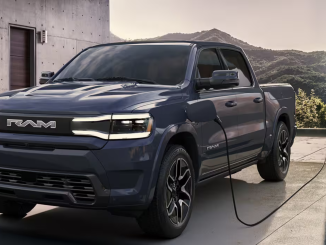
Buying a new truck in today’s economy is a big deal. Depending on options and trim lines, a new truck can easily cost you over $90,000. So before you pluck down those bucks, you better be sure that what you buy is what you really want and has the features that you really need. Sure, you can buy used, but there’s always an element of risk associated with buying a used truck from a total stranger without a warranty. Either way, it’s best to buy the right truck for a truck camper without having to go through the process again in a year or two. Who makes the best truck for a truck camper? Which truck offers the highest payload? We’ll take a look in this article.
Choosing the Right Truck for a Truck Camper
Remember when the terms half-ton, 3/4-ton, and a one-ton accurately represented the payload for each weight class of pickup truck? Well, those days are long gone with today’s trucks capable of hauling much more weight. For example, one Ram 3500 SRW 4WD short-bed truck we looked at recently had a payload of 3,358 pounds. Such increases are typical across the board. Today’s 3/4-ton trucks can deliver payloads up to 4,300 pounds, while today’s one-ton DRW trucks can haul loads up to 7,800 pounds. Most of today’s half-ton truck can haul loads around 2,000 pounds, a good 400 pounds more than the highest payloads offered of today’s tiny mid-size pickups.

When it comes to hauling a truck camper, nothing is more important than a truck’s payload rating. The payload is simply the amount of weight that the truck can safely haul and is a product of the truck’s Gross Vehicle Weight Rating (GVWR). The payload, expressed in both pounds and kilograms, can either be found on a driver door pillar sticker or in the glove box on a payload certification form. You can also determine the payload rating by subtracting the curb weight of your truck (you’ll need to take it to the scales to get this figure) from the truck’s GVWR. Basically, everything being carried in your truck, including all passengers, gear, and your “wet,” fully loaded truck camper, should be below your truck’s rated payload. Grossly exceeding the payload and GVWR is neither safe for your passengers nor for others who are sharing the road with you. Not only that, but prolonged use of your truck while greatly exceeding these ratings can not only result in frame, suspension, and tire failures, but can also void any warranties.

The following is a breakdown of GVWR numbers by truck class:
- Class 1: (Tacoma/Ranger/Colorado Mid-Size trucks): 0 to 6,000 pounds
- Class 2A (Ford F-150/Ram Chevy GMC 1500 trucks): 6,001 to 8,500 pounds
- Class 2B (Ford F-250/Ram Chevy GMC 2500 trucks): 8,501 to 10,000 pounds
- Class 3 (Ford F-450/Ford F-350/Ram Chevy GMC 3500 trucks): 10,001 to 14,000 pounds
- Class 4 (Ford F-450 chassis cab/Ram 4500 chassis cab trucks): 14,001 to 16,000 pounds
- Class 5 (Ford F-550 chassis cab/Ram 5500 chassis cab trucks): 16,001 to 19,500 pounds
When it comes to payload, options can either hurt or help your payload rating. As a truck camper owner, you should always opt for the “max tow package” or equivalent as this option maximizes payload. Conversely, the diesel option should be weighed carefully. Yes, having a shiny, new diesel engine underneath your hood is great for climbing mountains and raising your testosterone, but it’s also heavier, nearly twice as much as a gasoline V8, which mean less payload (more about the diesel engine below). Ditto for 4WD. That feature, while great for driving on rough roads, sand, and snow, isn’t so great for your payload rating—300 to 400 pounds extra over 2WD is typical. The same applies to cab size. The typical crew cab weighs more than 380 pounds than the regular cab. All of these extra “goodies” means less payload and when it comes to hauling a truck camper, that’s bad.

There is, however, a bright spot. The lone exception to the “more options is bad for payload” mantra is the dual rear wheel (DRW) truck. When it comes to payload, the dually is king and it isn’t even close. Yes, having an extra two wheels and tires on the rear axle makes the truck wider and less adept off-road, but it also adds more payload, a lot more. How much? In many cases 2,500 pounds more. This puts one-ton DRW payload ratings above 7,800 pounds, making the truck very appealing for those shopping for a long-bed truck camper with multiple slide-outs like the Lance 1172 and Host Mammoth. Still, this isn’t enough for some large campers. Some have resorted to even going with a better-rated F450/4500 or F550/5500 truck. We feature them all of the time here on Truck Camper Adventure.
The Gross Axle Weight Rating (GAWR) is another important rating when it comes to your truck. Each axle has an assigned GAWR, but the most important of the two is the rear axle since it will be bearing most of your cargo’s weight. You can find these ratings by looking at the truck’s axle and tire rating sticker or by looking at the truck’s payload certification form. If you closely examine these ratings you should see an increase over the GVWR when totaling them. This increase can vary anywhere between 100-500 pounds per axle. Exceeding the payload rating of a truck isn’t advisable, but these ratings can be used to squeeze out extra pounds of cargo carrying capacity. One should never exceed the GAWR of your axles, period.

The diesel engine is another hotly debated option. With the high cost of diesel at the pump and with today’s strict EPA standards you’d think the diesel would be dead in today’s auto and light truck market, but it hasn’t happened. Diesels still provide superior torque, better fuel mileage, and last longer than the typical gas engine (600,000 miles is not uncommon). They also hold their value better and have a “coolness” factor associated with them that a gas engine can’t touch. Yes, it’s true that the new requirement for diesel exhaust fluid (DEF) adds an additional burden for diesel ownership, but there’s also no denying that today’s diesel engine burns cleaner, is much quieter, and and doesn’t have the smell associated with them that they had in the past. The big negative, of course, is the payload loss associated with the heavier engine, so this must be carefully weighed against the positives and your own specific needs. Because of this I wouldn’t recommend a diesel for anything less than a one-ton truck.
Can today’s half-ton pickup truck haul a truck camper? The answer is yes, but with several caveats. It depends on the truck, the truck’s rated payload, and the size and weight of the camper you have in mind. For example, a 2022 Ford F-150 crew cab 2WD short-bed model has a rated payload of 1,980 pounds, while a Ford F-150 regular cab 2WD long-bed model has a much higher rating of 2,856. Most half-ton pickup trucks, however, are rated below 2,000 pounds. This reduced payload basically limits you to pop-up truck campers and smaller hard-slide campers like the Lance 650 and Cirrus 620. With the exception of the aforementioned Ford F-150, most half-tons will need upgrades to the shock absorbers, spring packs, brakes, and tires, the latter meaning a capacity improvement from the weak passenger tires that came with your truck to a set of good light truck (LT) tires with a load range of either D or E.

If you have your sights set on a double or triple-slide camper like those made by Lance, Host, and Rugged Mountain, a Class 4 or Class 5 chassis cab truck is the best option. These heavy-duty trucks not only have the requisite GVWR and payload to haul a fully loaded, 6,000-pound camper, but they can also be outfitted with an aftermarket truck bed with storage. Depending on the type of engine chosen (gas or diesel), today’s Ford F-550 and Ram 5500 trucks boast a payload rating between 9,500 and 12,500 pounds. Two lengths of chassis cab trucks are sold by Ford and Ram today: the 60 CA and the 84 CA chassis (the number is simply the distance, in inches, from the cab to the center of the axle). Going with an 84 CA is your best bet for those desiring to outfit their rig with an aftermarket truck bed with a spare tire garage midships. And don’t forget. When building your rig with an aftermarket truck bed be sure to observe the COG of your camper.
Due to the limited storage found in today’s truck campers, the aftermarket truck bed is the latest rage in the truck camper industry. Not only do these aftermarket truck beds offer more storage, but depending on the length, they can also be outfitted with spare tire garages, air compressors, extra gasoline and water holding tanks, batteries, and outdoor cooktops. The great thing about going the this route is that you don’t have to own a flatbed truck camper. Most aftermarket truck beds work with both traditional slide-in and flatbed campers. The best aftermarket truck bed builders for truck campers include Bowen Customs, the Aluma Tray by OEV, SherpTek, and StableCamper. If you’re looking for a traditional truck bed instead, then you’ll want to check out Elevation Off-Grid’s Class 4 and Class 5 trucks with the LiquidSpring suspension system and 41-inch super singles. Click here for a list of the best aftermarket truck camper manufacturers in today’s market.

So what’s the bottom line? What is the best truck for a truck camper? Well, if you’re buying your first truck and you’re looking seriously at getting a truck camper, we suggest skipping the half-ton and 3/4-ton and buy a one-ton truck instead like a Ford F-350, a Ram 3500, or a Chevy Silverado 3500HD at a minimum. It all comes down to payload and you want more of it. Don’t make the same mistake we made back in 2011 when we bought a lighter truck to save a little money. Back then, we bought a Ford F-250 4×2 with the 6.2L gas engine to get more payload—a fine truck in its own right—but missed having a 4WD drivetrain and a diesel. As a result, we ended up buying a Ram 3500 with the Cummins 6.7L engine two years later, the truck we should’ve bought from the start. So be wiser and buy a one-ton truck at a minimum from the start. Doing so will save you time, money, and frustration and will make you happier in the end.


















HI Mike, which bed size is better for a camper, length wise.
More options with 8-foot beds, but the shorter beds are better for off-roading.
I am looking to get a truck just for use with a camper. I didn’t think I wanted a diesel because of the cost/availability of fuel. What are your recommendations?
Get a one-ton truck, a Ford F350, a Chevy 3500 or a Ram 3500.
Thanks for the info Mike. Regarding your "mistake" (buying the Ford), what made you feel like it was a mistake? I know you said that you missed the diesel/4×4, but was that because of a lack of power or capability? I bought a '13 F250 (similar to yours) with the same thought concerning the payload. I intend to buy a camper in the 2800 lbs. (wet) range in the future. Just wondering if your personal experience hauling your camper is what made you change your mind. Thanks. Jeff
It was a mistake only because I wanted a 4×4 capability and diesel. If you want those things AND you want a decent payload, then you'll need to go with an F-350/3500. That 6.2L engine is a great engine for a gasser, plenty of power going up the steep overpasses and got decent gas mileage with the camper at 12 MPGs.
I am being told the payload on the F350 diesel is only 5600 at the most and Ive seen the payload stickers, are you able to get the extra payload for a 2 door only with no dually? My truck camper is 4,400 DRY so I will need at least 6000lbs for the 45 gallon fresh and black tanks, grey 23 WET along with passengers, cargo etc….what do you recommend? Ive talked to over 50 sales agents and no one can tell me!
Great. Thanks again!